1997 CADILLAC SEVILLE parking brake
[x] Cancel search: parking brakePage 95 of 370

Downloaded from www.Manualslib.com manuals search engine It’s better not to park with the engine running. But if you
ever have to, here are some things to know.
A CAUTION:
Idling the engine with the climate control system
off could allow dangerous exhaust into your
vehicle (see the earlier Caution under
“Engine Exhaust”).
Also, idling in a closed-in place can let deadly
carbon monoxide
(CO) into your vehicle even
if the fan switch is at the highest setting. One
place this can happen is
a garage. Exhaust -- with
CO -- can come in easily. NEVER park in a
garage with the engine running.
Another closed-in place can be
a blizzard. (See
“Blizzard” in the Index.)
A CAUTION:
It can be darlgerous to get out of your vehicle if
the shift lever
is not fully in PARK (P) with the
parking brake firmly set. Your vehicle
can roll.
Don’t leave your vehicle when the engine is
running unless you have to.
If you’ve left the
engine running, the vehicle can move suddenly.
You or others could be injured.
To be sure your
vehicle won’t move, even when you’re on fairly
level ground, always set your parking brake after
you move the shift lever to
PARK (P).
Follow the proper steps to be sure your vehicle won‘t
move. See ”Shifting Into
PARK (P)“ in the Index.
If you are parking on a hill and if you’re pulling a
trailer> also see “Towing a Trailer” in the Index.
Page 138 of 370
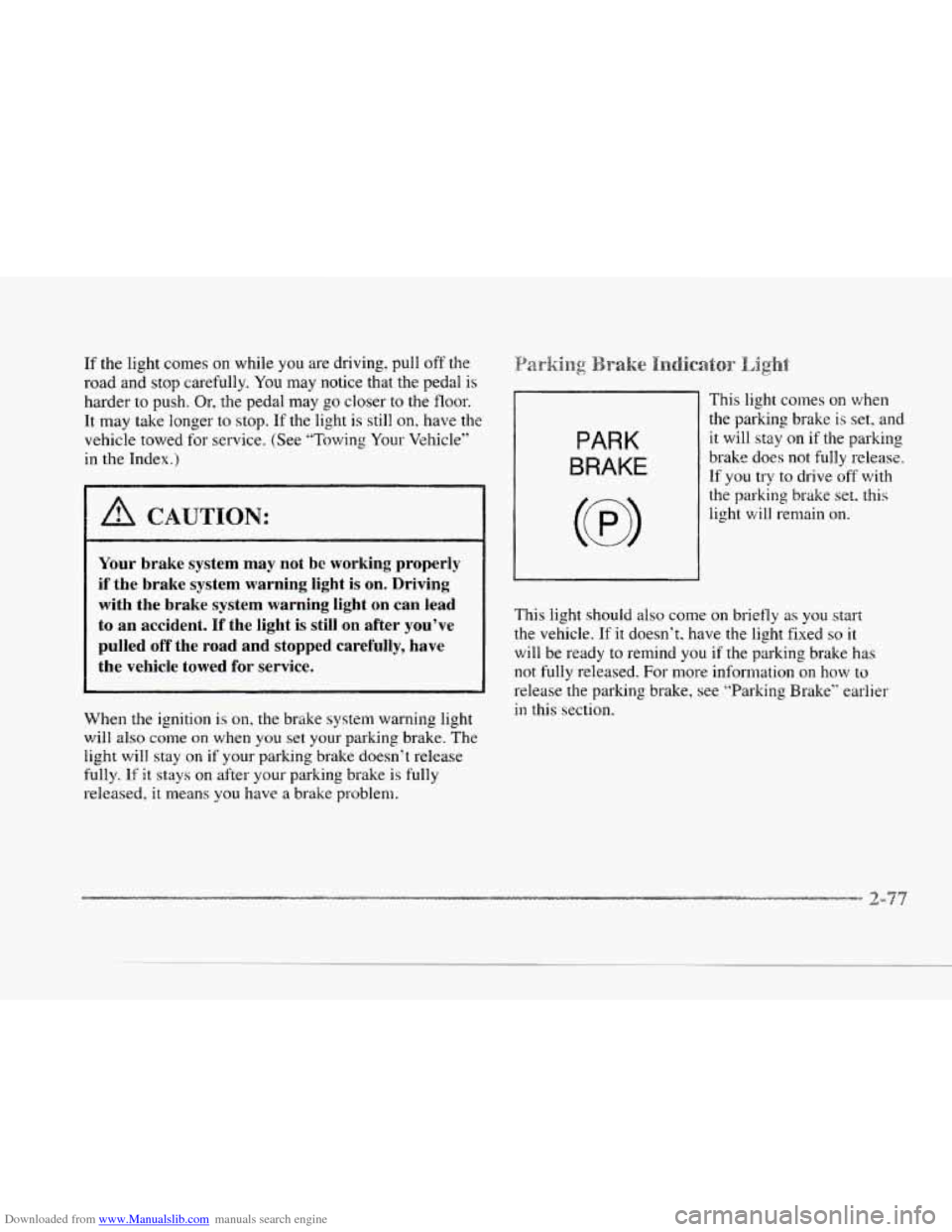
Downloaded from www.Manualslib.com manuals search engine If the light comes on while you are driving. pull off the
road and stop carefully. You may notice that the pedal is
harder to push. Or, the pedal may go closer to the floor.
It may take longer
to stop. If the light is still on. have the
vehicle towed
for service. (See ”Towing Your Vehicle’‘
in the Index.)
Your brake system may not be working properly
if the brake system warning light is
on. Driving
with the brake system warning light on can lead
to an accident. If the light
is still on after you’ve
pulled off the road and stopped carefully, have
the vehicle towed for service.
___ ~ ~
When
the ignition is on, the brake system warning light
will also come on when you set your parking brake. The
light will stay on if your parking brake doesn’t release
fully.
If it stays on after your parking brake is fully
released, it means
you have a brake problenl. This
light comes
on when
the parking brake is set, and
PARK
BRAKE
it will stay on if the parking
brake does
not fully release.
If you try to drive off with
the parking brake set. this
light will remain on.
This light should also come
on briefly as you start
the vehicle.
If it doesn’t, have the light fixed so it
will be ready to remind you if the parking brake has
not fully released. For more information on how to
release the parking brake, see “Parking Brake” earlier
in this section.
Page 201 of 370
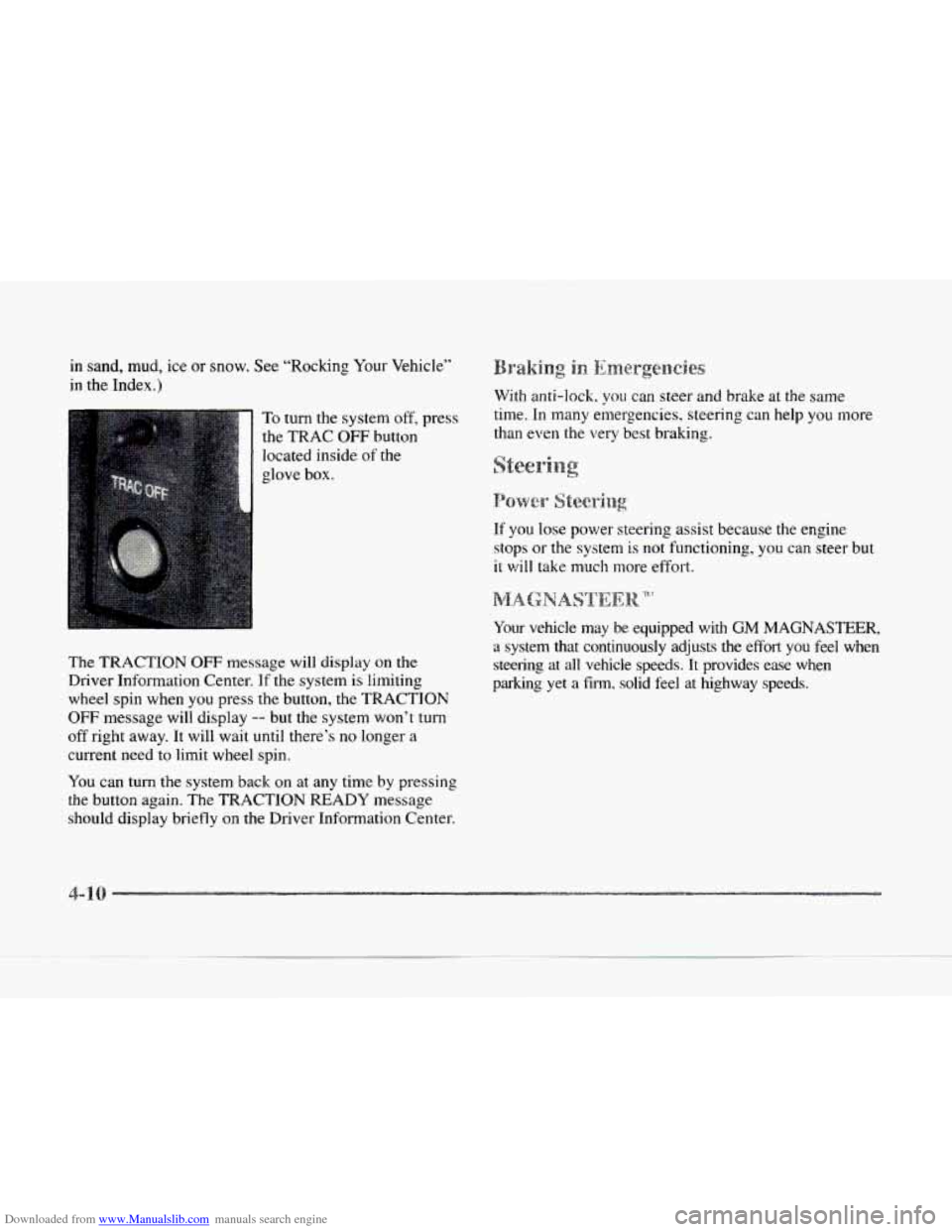
Downloaded from www.Manualslib.com manuals search engine in sand, mud, ice or snow. See “Rocking Your Vehicle”
in the Index.)
To turn the system off, press
the
TRAC OFF button
located inside
of the
I
glove box.
The
TRACTION OFF message will display on the
Driver Information Center.
If the system is limiting
wheel spin when you press the button, the
TRACTION
OFF message will display -- but the system won’t turn
off right away. It will wait until there’s no longer a
current need to limit wheel spin.
You can turn the system back on at any time by pressing
the button again. The TRACTION READY message
should display briefly
on the Driver Information Center. With
anti-lock,
you can steer and brake at the same
time. In many emergencies. steering can help you more
than even the very best braking.
eeri
If you lose power steering assist because the engine
stops or the system
is not functioning, you can steer but
it
will take much more effort.
Your vehicle may
be equipped with GM MAGNASTEER,
a system that continuously adjusts the effort you feel when
steering at all vehicle speeds. It provides ease when
parking
yet a film. solid feel at highway speeds.
Page 229 of 370
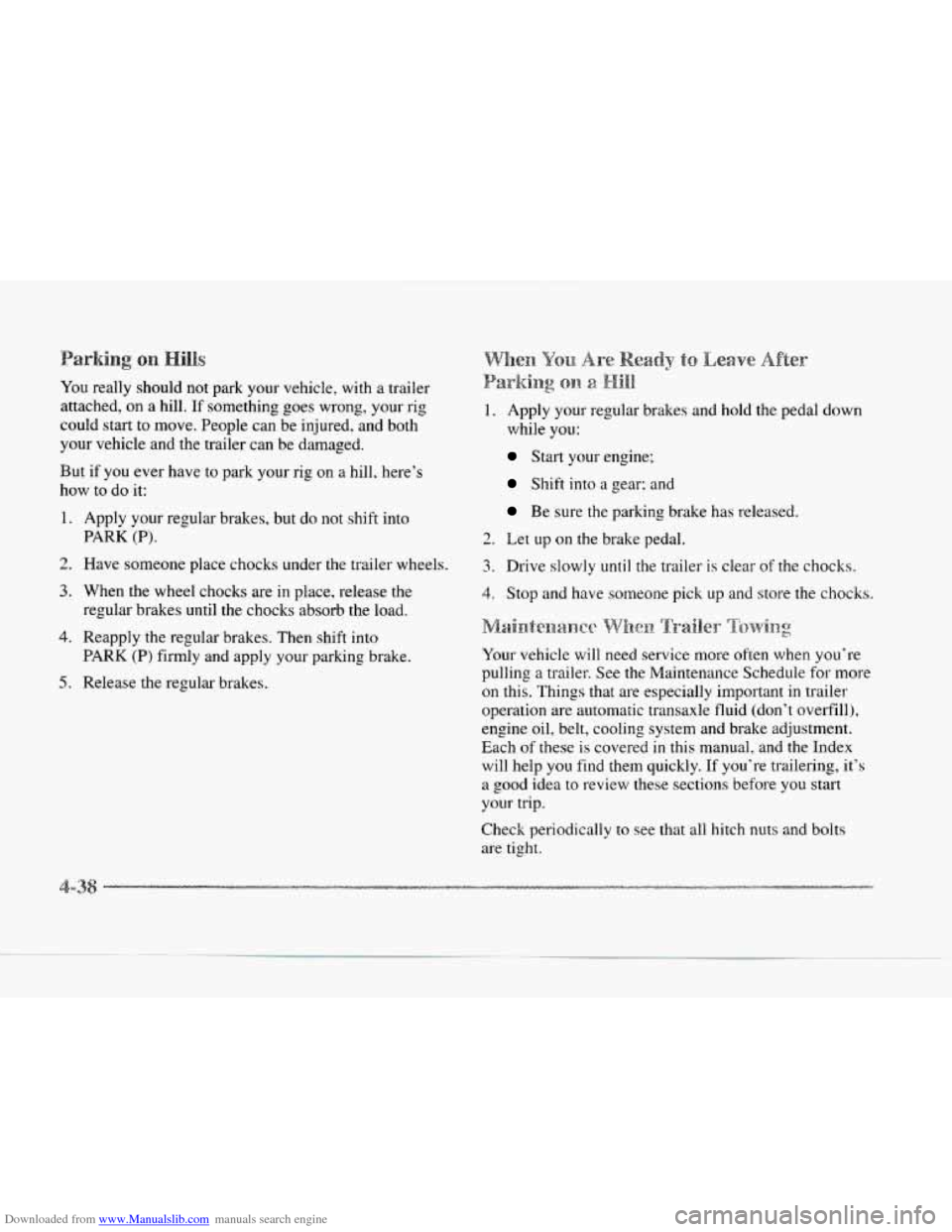
Downloaded from www.Manualslib.com manuals search engine You really should not park your vehicle, with a trailer
attached, on
a hill. If something goes wrong, your rig
could start to move. People can be injured, and both
your vehicle and
the trailer can be damaged.
But if
you ever have to park your rig on a hill. here’s
how to do it:
1.
2.
3.
4.
5.
Apply your regular brakes, but do not shift into
PARK
(P).
Have someone place chocks under the trailer wheels.
When the wheel chocks are in place, release the
regular brakes until the chocks absorb the load.
Reapply the regular brakes. Then shift into
PARK (P) firmly and apply your parking brake.
Release the regular brakes. 1. Apply your regular brakes and hold the pedal
down
while
you:
Start your engine;
Shift into a gear: and
Be sure the parking brake has released.
2. Let up on the brake pedal.
3. Drive slowly until the trailer is clear of the chocks.
4. Stop and have someone pick up and store the chocks.
Your vehicle will need service more often when you’re
pulling
a trailer. See the Maintenance Schedule for more
on
this. Things that are especially important in trailer
operation are automatic transaxle fluid (don’t overfill),
engine oil, belt, cooling system and brake adjustment.
Each of these
is covered in this manual, and the Index
will help you find them quickly. If you’re trailering, it’s
a good idea to review these sections before you start
your trip.
Check periodically to see that all hitch nuts and
bolts
are tight.
Page 242 of 370

Downloaded from www.Manualslib.com manuals search engine c
c
A CAUTION:
A vehicle can fall from a car-carrier if it isn’t
adequately secured. This can cause
a collision,
serious personal injury and vehicle damage. The
vehicle should be tightly secured with chains or
steel cables before it
is transported.
Don’t
use substitutes (ropes, leather straps,
canvas webbing, etc.) that can be cut by sharp
edges underneath the towed vehicle. Always use
T-hooks inserted in the front T-hook
slots or
R-hooks inserted in the rear R-hook slots. Never
use J-hooks. They will damage drivetrain and
suspension components.
When your vehicle is being towed, have the ignition
key turned to the
OFF position. The steering wheel
should be clamped in a straight-ahead position, with a
clamping device designed for towing service.
Do not
use the vehicle’s steering column lock for this. The
transaxle should be in
NEUTRAL (N) and the parking
brake released.
Don’t have your vehicle towed
on the drive wheels
unless
you must. If the vehicle must be towed on the
drive wheels, be sure to follow the speed and distance
restrictions later in this section or your transaxle will be
damaged.
If these limitations must be exceeded, then the
drive wheels have to be supported
on a dolly.
Page 257 of 370
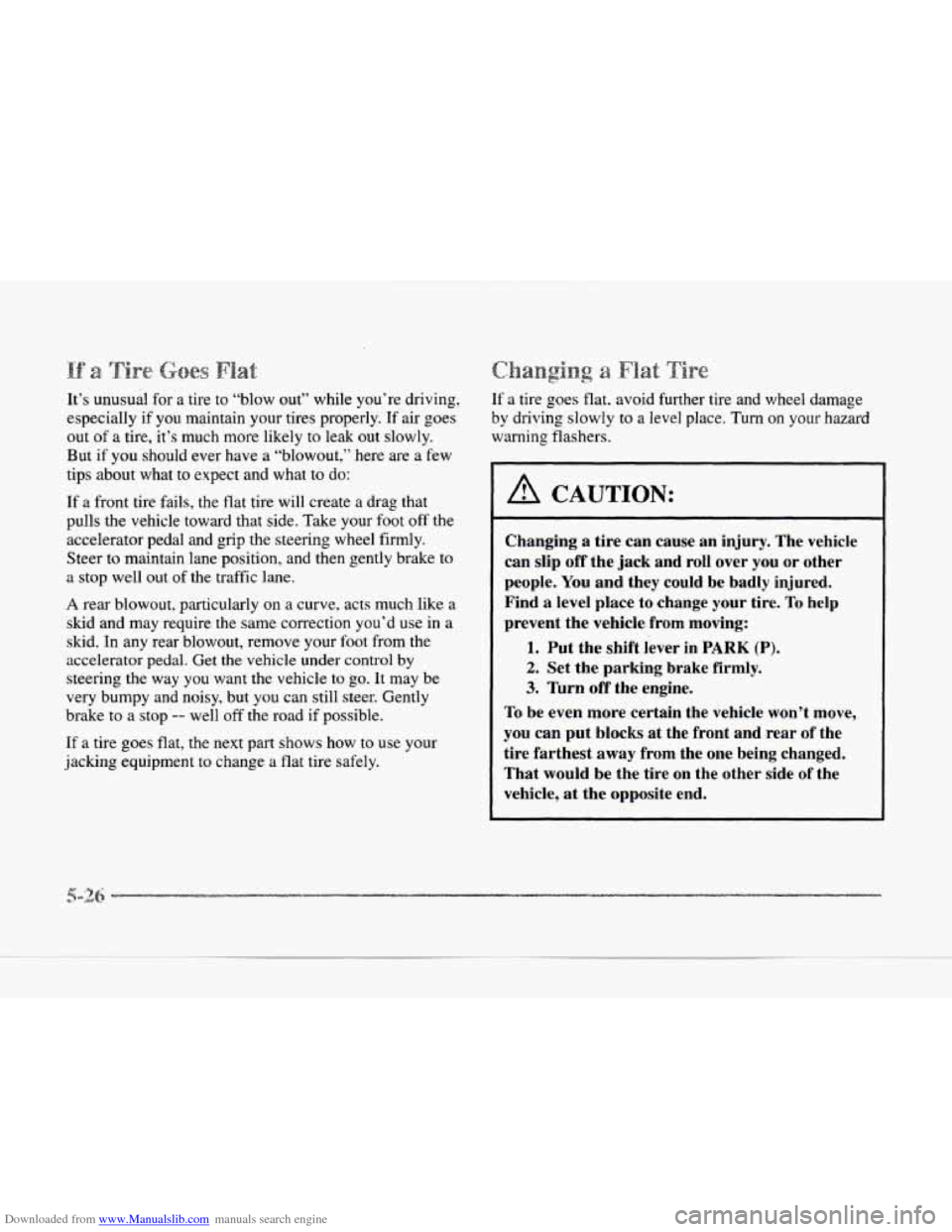
Downloaded from www.Manualslib.com manuals search engine It’s unusual for a tire to “blow out” while you’re driving,
especially if you maintain your tires properly. If air goes
out
of a tire, it’s much more likely to leak out slowly.
But if you should ever have
a “blowout,” here are a few
tips about what to expect and what to do:
If
a front tire fails, the flat tire will create a drag that
pulls the vehicle toward that side. Take your foot
off the
accelerator pedal and
grip the steering wheel firmly.
Steer to maintain lane position, and then gently brake to
a stop well out of the traffic lane.
A rear blowout, particularly on a curve. acts much like a
skid and may require the same correction you’d use in a
skid. In any rear blowout, remove your foot from the
accelerator pedal. Get
the vehicle under control by
steering the way
you want the vehicle to go. It may be
very bumpy and noisy, but you can still steer. Gently
brake
to a stop -- well off the road if possible.
If a tire goes flat, the
next part shows how to use your
jacking equipment
to change a flat tire safely.
If a tire goes flat. avoid further tire and wheel damage
by driving slowly to a level place. Turn on your hazard
warning flashers.
I A CAUTION:
Changing a tire can cause an injury. The vehicle
can slip
off the jack and roll over you or other
people. You and they could be badly injured.
Find
a level place to change your tire. To help
prevent the vehicle from moving:
1. Put the shift lever in PARK (P).
2. Set the parking brake firmly.
3. Turn off the engine.
To be even more certain the vehicle won’t move,
you can put blocks
at the front and rear of the
tire farthest away from the one being changed.
That would be the tire on the other side of the
vehicle,
at the opposite end.
Page 289 of 370
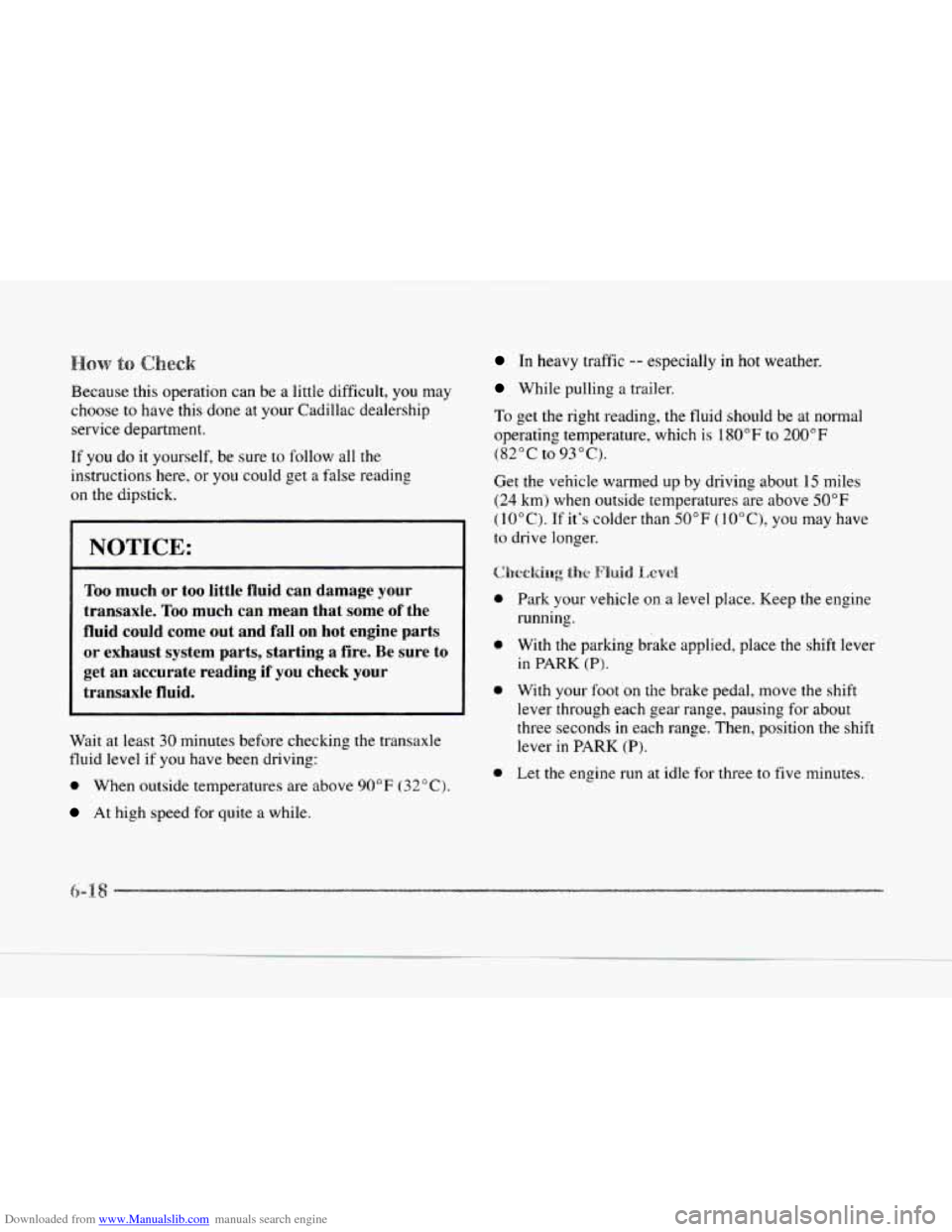
Downloaded from www.Manualslib.com manuals search engine Because this operation can be a little difficult, you may
choose
to have this done at your Cadillac dealership
service department.
If
you do it yourself, be sure to follow all the
instructions here, or
you could get a false reading
on the dipstick.
NOTICE:
Too much or too little fluid can damage your
transaxle. Too much can mean that some of the
fluid could come out and fall on hot engine parts
or exhaust system parts, starting
a fire. Be sure to
get an accurate reading
if you check your
transaxle fluid.
Wait at least 30 minutes before checking the transaxle
fluid level if you have been driving:
0 When outside temperatures are above 90°F (32°C).
At high speed for quite a while.
In heavy traffic -- especially in hot weather.
While pulling a trailer.
To get the right reading, the fluid should be at not-mal
operating temperature, which is 180°F to 200'F
Get the vehicle warmed up by driving about 15 miles
(24 km) when outside temperatures are above 50°F
(10OC). If it's colder than 50°F (lO"C), you may have
to drive longer.
(820~ to 93"~).
$:iiaeckirrg &he Fluid LJ4397CI
0
0
0
0
Park your vehicle on a level place. Keep the engine
running.
With the parking brake applied, place the
shift lever
in PARK (PI.
With your foot on the brake pedal. move the
shift
lever through each gear range, pausing for about
three seconds
in each range. Then, position the shift
lever in PARK
(P).
Let the engine run at idle for three to five minutes.
--
-4
.1
Page 359 of 370
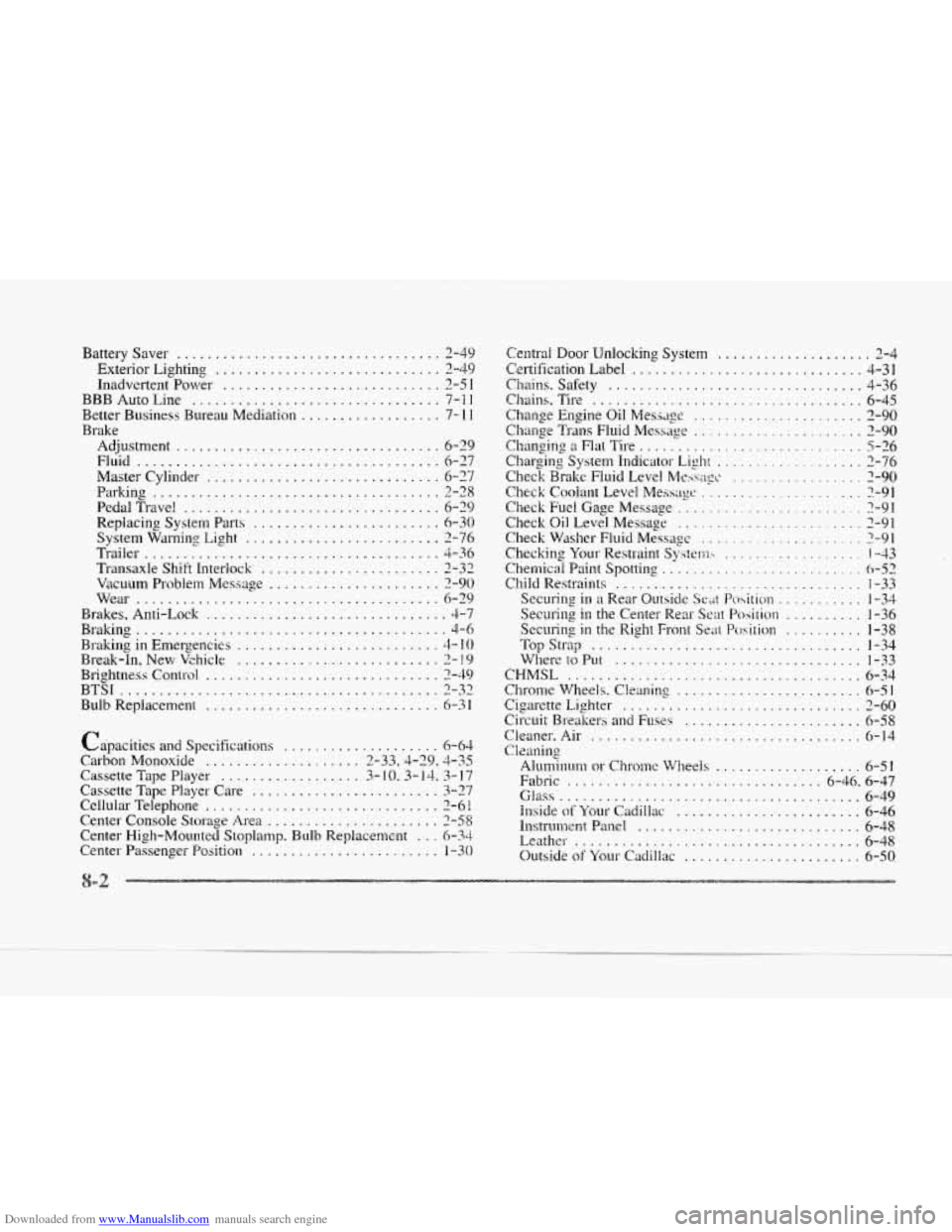
Downloaded from www.Manualslib.com manuals search engine Battery Saver .................................. 2-49
Exterior Lighting ............................. 2-Li.9
Inadvertent Power ............................ 2-5 1
BBB Auto Line ................................ 7-1 1
Better Business Bureau Mediation .................. 7- 11
Brake
Adjustment
.................................. 6-29
Master Cylinder .............................. 6-37
Parking ..................................... 2-28
PedalTravel ................................. 6-29
Replacing System Parts ........................ 6-30
System Warning Light ......................... 2-76
T~diier ...................................... 4-36
Transaxle Shift Interlock ....................... 2-32
Vacuum Problem Message ...................... 2-90
Wear ....................................... 6-29
Brakes. Anti-Lock ............................... 4-7
Bra~ng ........................................3.- 6
Braking in Emergencies .......................... 4- 10
Break-In. New Vehicle .......................... 2- 9
BTSI ......................................... .- 32
Fluid ....................................... 6-27
Brightness Control .............................. 3-49
Bulb Replacement .............................. 6-31
c&u5ties and Specifications .................... 6-64
Carbon Monoxide .................... 2-33,4-39.3-35
Cassette Tape Player .................. 3- IO . 3- 147- 17
Cassette Tape Player Care ........................ 3-37
Cellular Telephone .............................. 3-6 I
Center Console Storage Area ...................... 7-58
Center High-Mounted Stoplamp . Bulb Replacement ... 6-34
Center Passenger Position ........................ i -30
Central Door Unlocking System .................... 2-4
Certification Label .............................. 4-31
Chains. Safety ................................. 4-36
Chains. Tire ................................... 6-45
Clmnst: Engine Oil
MesaLqc ...................... 2-90
Change Trans Fluid Message ...................... 2-90
Chang.ing a Flai Tire ............................. 5-26
Charpg System Indicator Light ................... 2-76
Check Brake Fluid Level Messuyc ................. 2-90
Check Cooiant Level Messagc ..................... 2-91
Check Fuel Gage Message ........................ ?-91
Check Oil Level Message ........................ 2-91
Check Washer Fluid Messase ..................... 2-91
Checking Your Restraint System :.. .................. 1 . -43
Chemical Paint Spotting .......................... 6-52
Child Restraints ................................ 1-33
Securing in a Rear Outside Seiit Position ........... 1-34
Securing in the Center Rear Seat Posi:ion .......... 1-36
Securing in the Right Front Seat Pwirion .......... 1-38
Topstrap ................................... 1-34
V4her-e to Put ................................ 1-33
CHMSL ...................................... 6-34
Chrome Wheels . Cleaning ........................ 6-51
Cigarette Lighter ............................... 2-60
Circuit Breakers and Fuses ....................... 6-58
Cleaner.Air ................................... 6-14
Ckaning
Alummum or Chrome Wheels ................... 6-51
Fabric ................................. 6-46.6-47
lnside of Your Cadillac ........................ 6-46
Instrument
Panel ............................. 6-38
Leatlm ..................................... 6-48
Outside
of Your Cadillac ....................... 6-50
Glass ....................................... 6-49